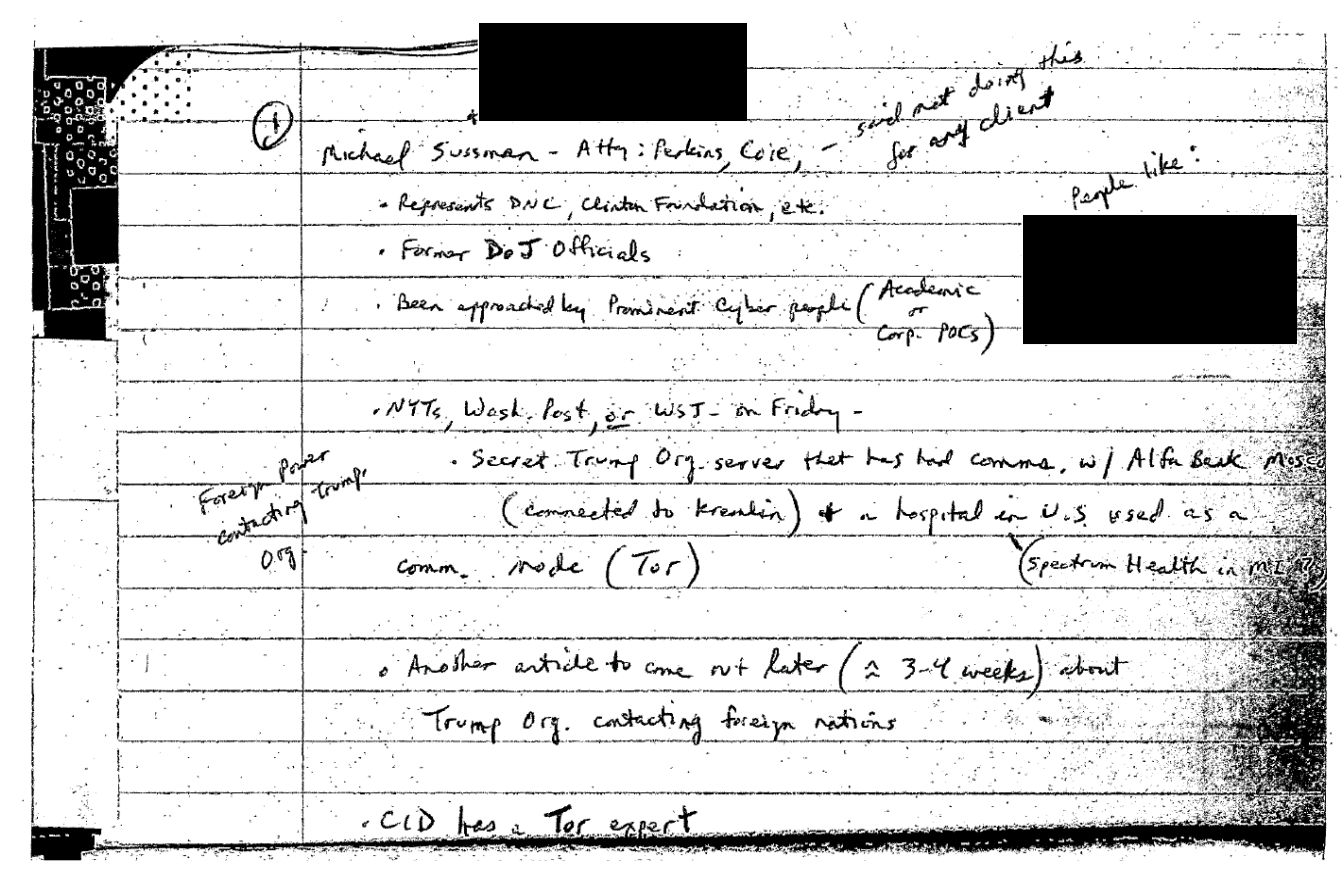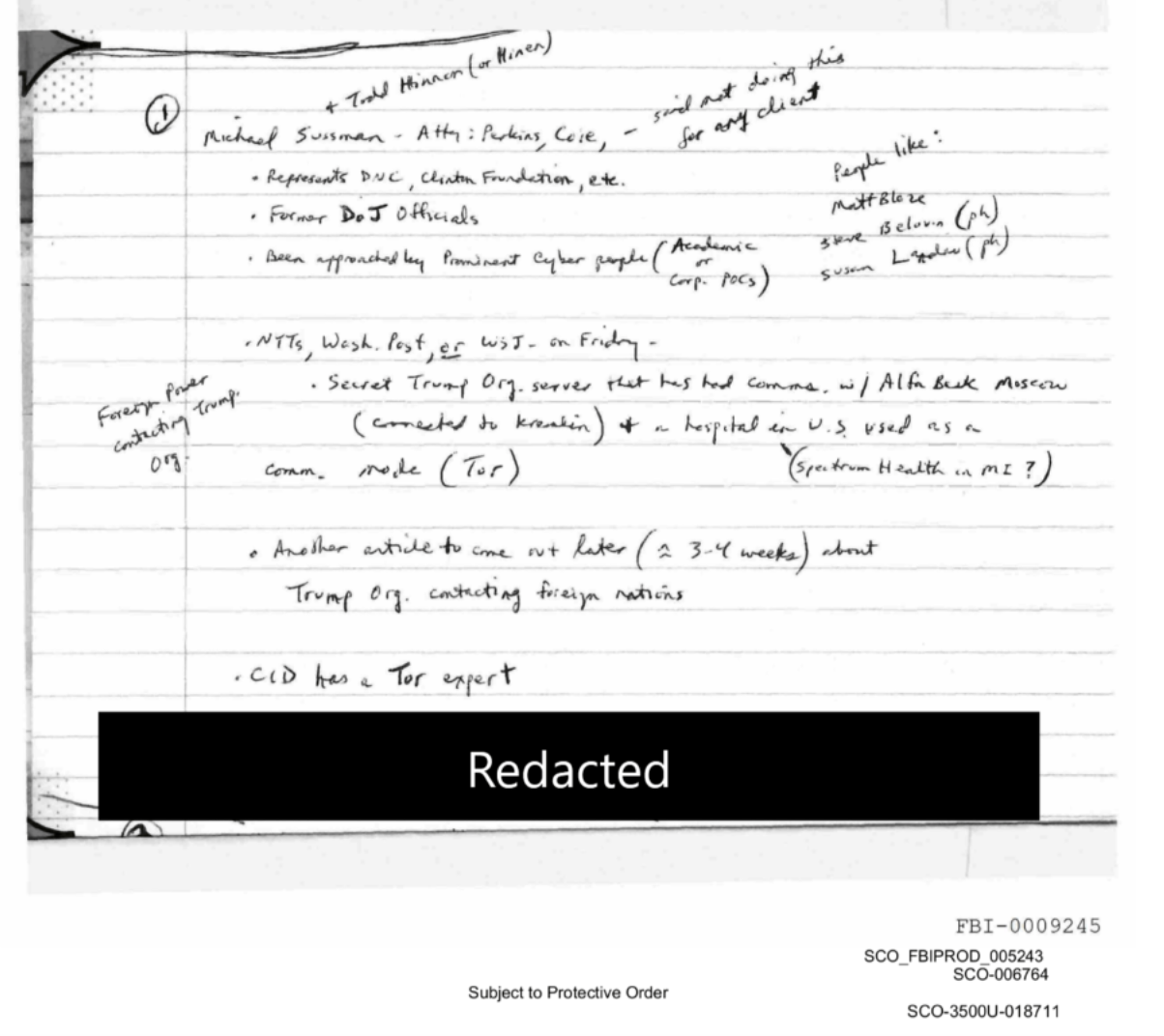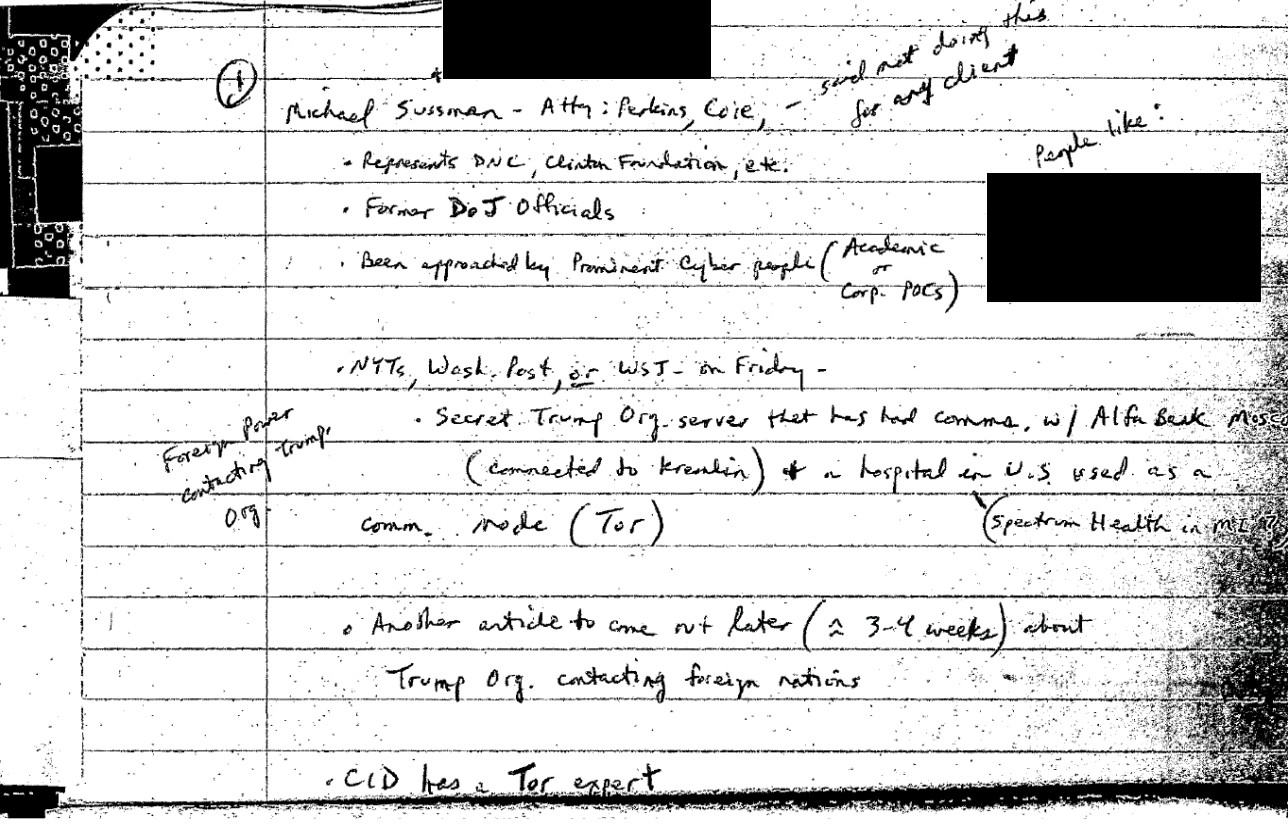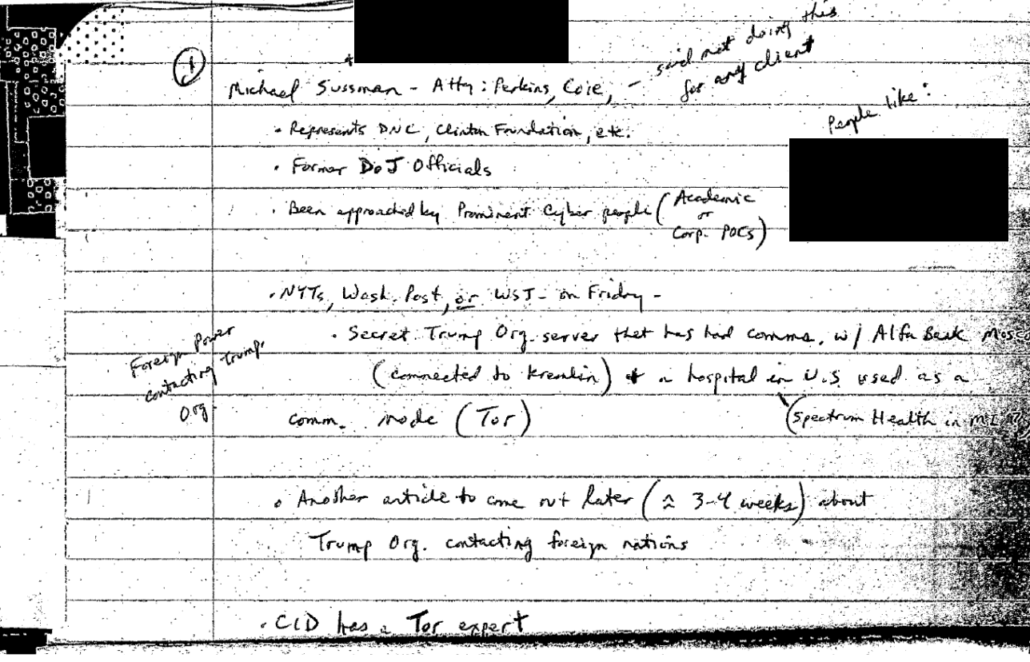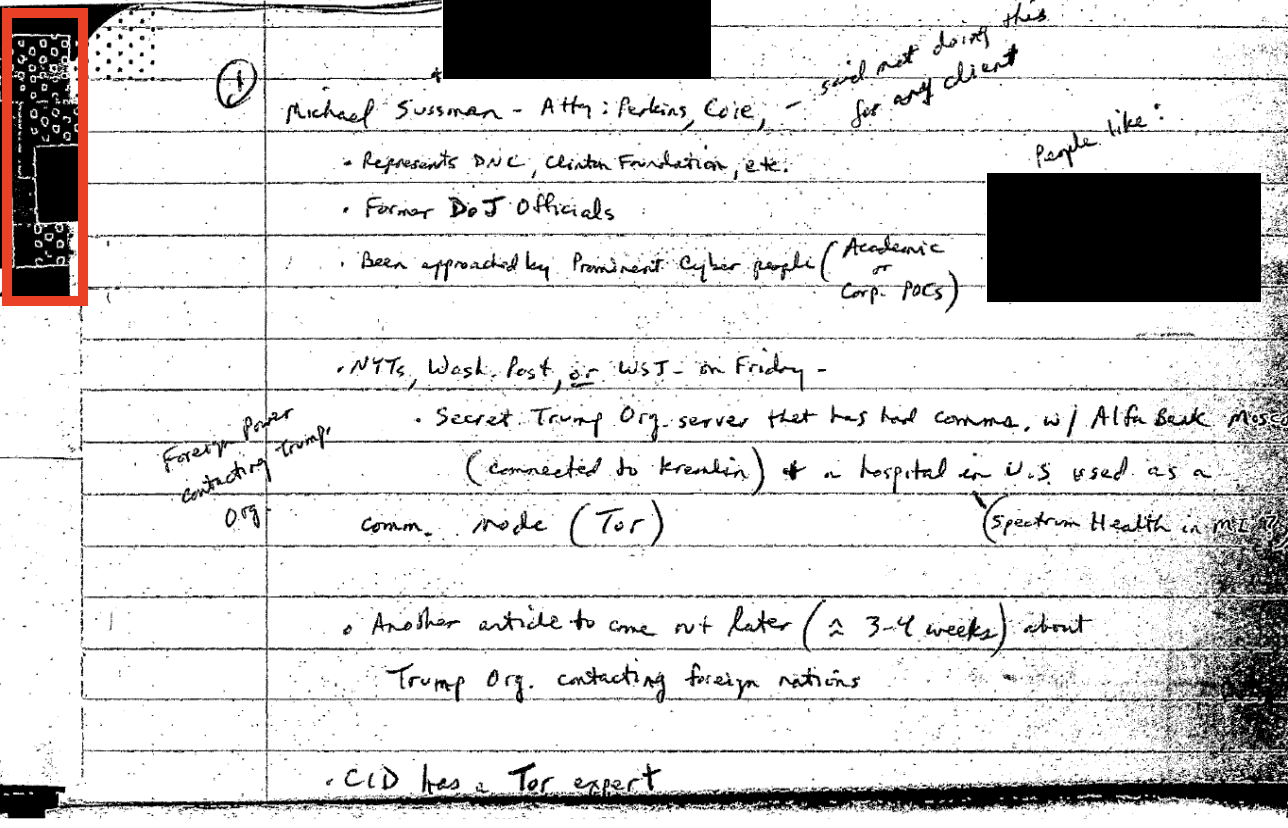On Monday, both John Durham and Michael Sussmann submitted their motions in limine, which are filings to argue about what can be admitted at trial. They address a range of issues that I’ll cover in several posts:
Sussmann:
Durham wants to:
- Admit witnesses’ contemporaneous notes of conversations with the FBI General Counsel
- Admit emails referenced in the Indictment and other, similar emails (see this post)
- Admit certain acts and statements (including the defendant’s February 2017 meeting with a government agency, his December 2017 Congressional testimony, and his former employer’s October 2018 statements to the media) as direct evidence or, alternatively, pursuant to Federal Rule of Evidence 404(b)
- Exclude evidence and preclude argument concerning allegations of political bias on the part of the Special Counsel (addressed in this post)
- Admit an October 31, 2016 tweet by the Clinton Campaign
I will link my discussions in serial fashion.
In John Durham’s bid to introduce notes from Bill Priestap and Trisha Anderson, he presented a color scan of Anderson’s notes [red annotation added]:

But he presented a black and white scan of Priestap’s notes [red annotation added]:
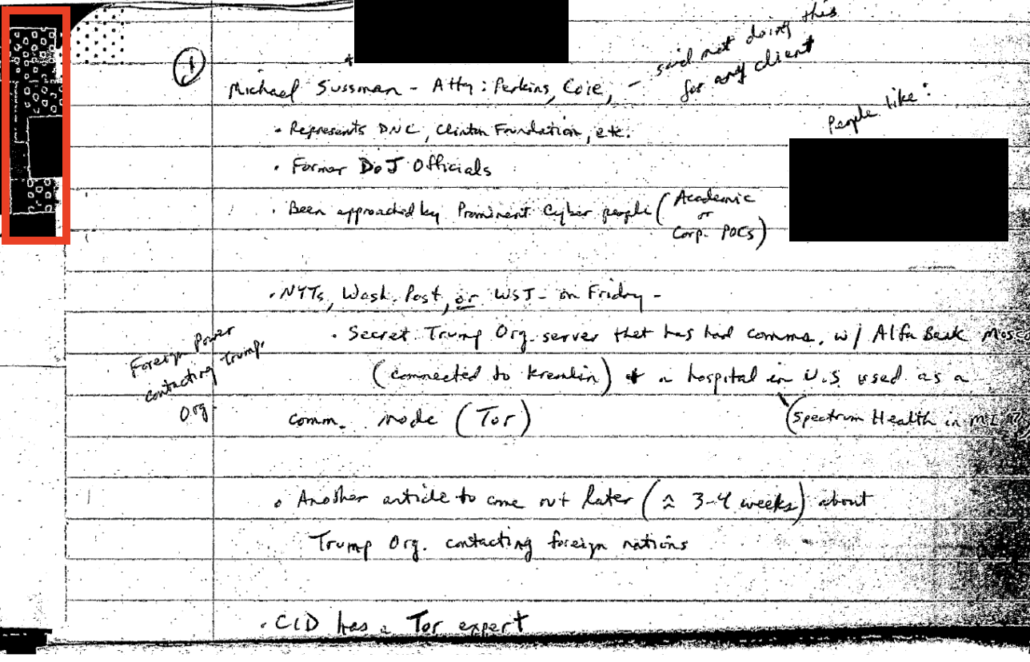
That’s important for two reasons. First, because blue sticky tabs were implicated in altered documents submitted in the Mike Flynn case. There was a blue sticky tab on another page of Priestap notes submitted in Flynn’s case.

There were what appear to be blue and red stickies visible on the original version of some Peter Strzok notes submitted in that case.
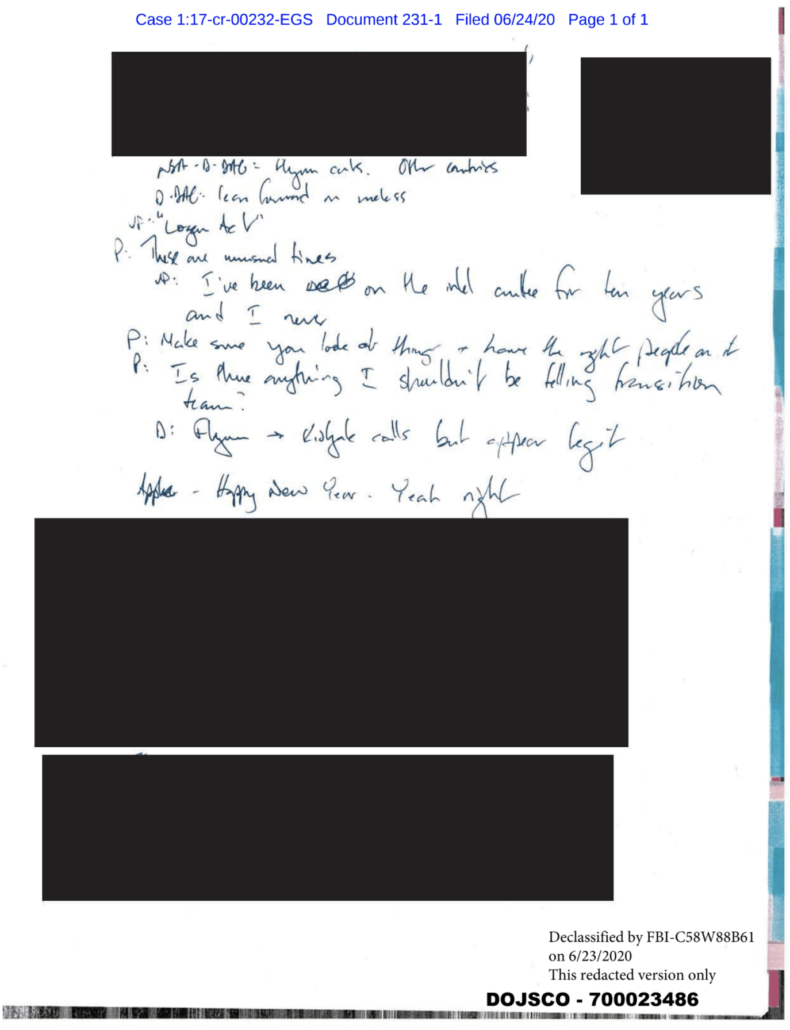
When the government ultimately confessed to adding dates (affirmatively misleading, in at least one case) to both that set of Strzok notes …
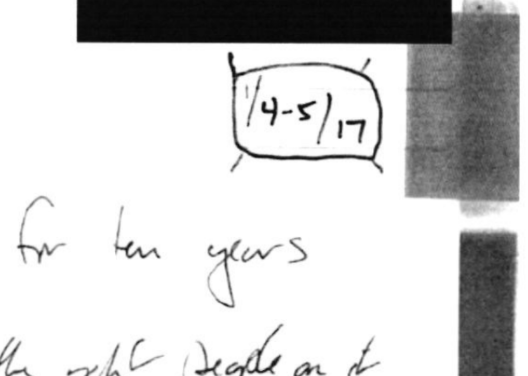
And some Andrew McCabe notes …
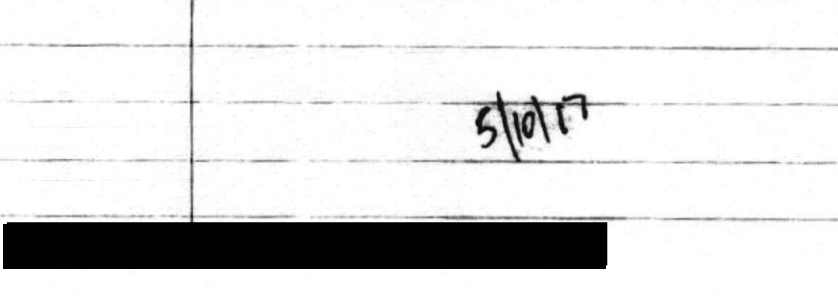
… The government claimed that the date added to some Andrew McCabe notes was added via a blue sticky — what sounds like the same sticky we saw in the Priestap notes.
In response to the Court and counsel’s questions, the government has learned that, during the review of the Strzok notes, FBI agents assigned to the EDMO review placed a single yellow sticky note on each page of the Strzok notes with estimated dates (the notes themselves are undated). Those two sticky notes were inadvertently not removed when the notes were scanned by FBI Headquarters, before they were forwarded to our office for production. The government has also confirmed with Mr. Goelman and can represent that the content of the notes was not otherwise altered.
Similarly, the government has learned that, at some point during the review of the McCabe notes, someone placed a blue “flag” with clear adhesive to the McCabe notes with an estimated date (the notes themselves are also undated). Again, the flag was inadvertently not removed when the notes were scanned by FBI Headquarters, before they were forwarded to our office for production. Again, the content of the notes was not otherwise altered. [my emphasis]
If that’s right, then whoever altered the McCabe notes altered them with the same kind of blue sticky note that appears on the Priestap notes that Durham wants to submit at trial.
Whether that date was added via blue sticky note has never been publicly tested. Rather than submitting unaltered versions of McCabe’s notes in the Flynn docket, DOJ — metadata suggests that Jocelyn Ballantine did this — simply digitally removed the date and a footer, effectively submitting a realtered exhibit in place of an altered one. So one cannot rule out that that date was written right onto the notes themselves. McCabe was being specifically prevented by DOJ from reviewing his original notes in the period, not even to prepare for Senate Judiciary Committee testimony, so he hasn’t been able to test that either.
That, by itself, suggests some of the alterations that were an issue in the Flynn docket were altered before they were shared with Jeffrey Jensen.
But that’s all the more interesting given a detail that Michael Sussmann included in his bid to exclude these notes. In Priestap’s grand jury testimony in this case, he testified he didn’t know why he wrote the “no specific client” comment on a slant, or why those notes were, “perhaps darker or thicker than some of the other notes.”
The Indictment characterizes the Priestap Notes as a contemporaneous record of Mr. Priestap’s conversation with Mr. Baker. See id. But beyond offering that they “looked like his writing and organizational style,” Mem. of Special Counsel’s June 2, 2021 Interview of E.W. Priestap, SCO-3500U-018701, at -01, Mr. Priestap said he “[doesn’t] remember why [he] wrote them down and who gave [him] the information,” E.W. Priestap’s June 3, 2021 Grand Jury Test., SCO-3500U-018746, at -98. Not only that, but Mr. Priestap “[does] not recall actually writing these notes,” id. at SCO-3500U-018815, nor can he confirm that the notes actually reflect any conversation he had with Mr. Baker, as opposed to a conversation he had with someone else, id. Indeed, Mr. Priestap “advised he did not remember Baker conveying to him the information about Sussmann,” Mem. of Special Counsel’s June 2, 2021 Interview of E.W. Priestap at SCO-3500U 018702, and was “not certain whether th[e] conversation reflected in the notes . . . was with Mr. Baker or maybe with someone else,” E.W. Priestap’s June 3, 2021 Grand Jury Test. at SCO3500U-018815. Mr. Priestap also has “[n]o idea” why the phrase “said not doing this for any client”—written diagonally to the side of the main body of the notes—was written at all, and could offer no explanation for why those words were “perhaps darker or thicker than some of the other notes.” Id. at SCO-3500U-018816.
The date in the January 24, 2017 Priestap notes is even more irregular — at cross-direction from his other notes on the page, and with uneven ink — and I have always wondered whether that date was added too.
And lo and behold, the Anderson notes also appear to have a sticky note right by the date (as annotated), albeit apparently a red one, though some of the tags on the Strzok notes were of a similar color. She also found aspects of her notes surprising.
Ms. Anderson’s notes (the “Anderson Notes”) include, on top, “Deputies Mtg. 9/19/16,” and then, after a redaction and under a second heading reading “9/19[/]16,” go on to state: “Sussman[n] Mtg w/ Baker” and “No specific client but group of cyber academics talked w/ him abt research,” followed by the phrase, “article this Friday – NYT/WaPo/WSJ.” Anderson Notes at SCO-3500U-000018. The relevant sentence fragment contains no subject revealing who had “[n]o specific client,” nor any other context for that phrase. Ms. Anderson, who was first asked about these notes by the Special Counsel over five years after they were written, has no meaningful memory of the notes or their context: she has only a “vague recollection” of discussing this topic with Mr. Baker and cannot “recall specifics.” Mem. of Special Counsel’s Jan. 5, 2022 Interview of T. Anderson, SCO-3500U-000087, at -88, -96. When shown the notes, Ms. Anderson stated that she had been “surprised” to learn about the “no specific client” phrase, and she “d[id] not now recall hearing from Baker his use” of that phrase; she could only assume that she got that phrase from Mr. Baker “because her notes reflect[ed] it.” Id. at -88.
Durham has only provided a partial scan of theses notes, hiding that the date, 9/19/16, appears earlier on the page, describing a different kind of meeting. That’s consistent with what the added date and the redaction on the McCabe notes did: It served to suggest that McCabe briefed the Flynn case to SSCI the day after Jim Comey was fired. Here, the September 19 date that appears next to the sticky is necessary for Durham’s case to claim that Anderson took these notes the same day of the meeting and not some time after that.
But why would Anderson date her notes twice?
According to a discovery filing in this case, Sussmann has reviewed redacted versions of the originals of the Priestap notes, which were still in the notebook Priestap took them in.
On October 13, 2021, the defense requested, among other things, to inspect the original notes that a former FBI Assistant Director of Counterintelligence took reflecting the defendant’s alleged false statement. The original notes were contained in a hard-bound notebook located at FBI Headquarters and contained extremely sensitive and highly classified information on a variety of topics and unrelated investigative matters. The Government immediately agreed to make the original notebook available to the defense in redacted form, and the defense conducted its review of the notebook on October 20, 2021.
But to test why all these notes have post-it notes on them and why the dates are so unreliable (and affirmatively misleading, in the case of the alteration in the January 5, 2017 Strzok notes), Sussmann would need to review all the notes together, probably with the assistance of the original authors.
It’s still not clear who altered the notes submitted in the Flynn docket, the extent of those alterations, or why the government is submitting exhibits with investigative stickies on them as evidence at trial. DOJ’s filing in the Flynn case blamed the misleading date on the Strzok notes on an FBI agent associated with the Jeffrey Jensen investigation (which would suggest that alteration post-dated Durham’s access to it), but it did not say who altered the McCabe notes.
But by showing that the blue sticky notes existed in Durham’s copy of the exhibits, Durham makes it clear some of the alterations exhibited in the Flynn docket happened before he shared the documents with Jensen’s investigation, if that’s how the notes got shared around.
The misleading date added to the Strzok notes ultimately was part of a packaged Trump attack on Joe Biden at the first debate, one that Sidney Powell, who has since been sanctioned for making fraudulent claims in an attempt to keep Trump in office, appears to have had a part in.
President Donald J. Trump: (01:02:22)
We’ve caught them all. We’ve got it all on tape. We’ve caught them all. And by the way, you gave the idea for the Logan Act against General Flynn. You better take a look at that, because we caught you in a sense, and President Obama was sitting in the office.
Given that even Chuck Grassley recognized the alteration added to the Strzok notes was incorrect, it’s hard to believe that was an innocent mistake.
And yet, 18 months later, DOJ is still trying to submit notes with all these investigative sticky notes as exhibits, without explaining why or how they appeared there.
And Durham’s choice to present the Priestap notes — with what appear to be the same blue sticky as appeared on his earlier notes, as well was the the blue sticky described to have been used to alter the McCabe notes — in black-and-white suggests he may know that’s a problem.


